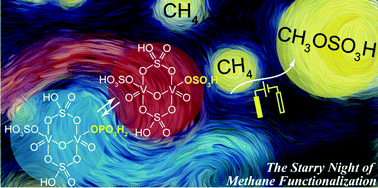Bisulfate as a redox-active ligand in vanadium-based electrocatalysis for CH4 functionalization†
Abstract
The roles of unforgiving H2SO4 solvent in CH4 activation with molecular catalysts have not been experimentally well-illustrated despite computational predictions. Here, we provide experimental evidence that metal-bound bisulfate ligand introduced by H2SO4 solvent is redox-active in vanadium-based electrocatalytic CH4 activation discovered recently. Replacing one of the two terminal bisulfate ligands with redox-inert dihydrogen phosphate in the pre-catalyst vanadium (V)-oxo dimer completely quenches its activity towards CH4, which may inspire environmentally benign catalysis with minimal use of H2SO4.

- This article is part of the themed collection: Functionalization of unreactive C-H bonds


 Please wait while we load your content...
Please wait while we load your content...